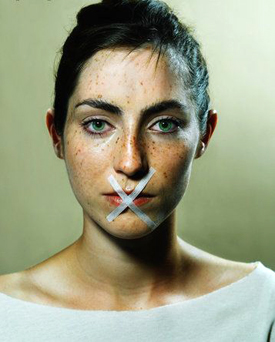Not In Our Family: Domestic Violence In The LGBT Community
The LBGT community consistently works towards implementing important legislation to protect LGBT members from hate crimes. But, as headlines announce this vital accomplishment, 30% of LGBT couples find themselves entangled in the quagmire of domestic abuse. Don’t be dismayed. Domestic violence is full of equal opportunity. The same percentage of domestic violence occurs in the straight world. Domestic violence is found among all communities. Domestic violence is not a crime of bigger or smaller, black or white, or substance abuse, or any other variable, The only two things domestic violence represents is that it is a crime of power and control.
There are glaring differences in the LGBT community. Domestic violence, when found in the LGBT community, shows a lack of resources, lack of awareness, and a wide denial among the LGBT members. The Gay Men’s Violence Project in Massachusetts relates the following story.

Brad was sixteen when he met twenty-seven year-old Michael. Their attraction was immediate and within two weeks, Brad had moved into Michael’s apartment. The cycle of abuse began with verbal put-downs, and progressed to slaps and shoves. One day, Brad appeared at a county emergency room, with a broken nose. At this point, Brad moved out and went back to his family’s home.
Six months later, Michael came back into Brad’s life. He had quit drinking and was a new man, ready to take care of Brad. This time the “honeymoon” lasted much longer. Michael and Brad formed a business together, bought a farm in the country, and shared financial and social resources.
However, when Michael began drinking again, so did the physical and verbal abuse. Brad continued to hope that the abuse would stop. His frequent trips to the ER were a great source of shame for Brad. Each incident was followed by pleas for forgiveness from Michael. Soon the cycle would begin again. Finally, one day, Michael beat Brad to such a degree that his ribs were broken, and the doctor said there could have been possible brain damage, if the beating had gone on much longer.
Brad left with nothing. In order to save his life he lost his business, home, and the world of friends he had cultivated with Michael. This story is an all too common example of the cycle and consequences of domestic violence between gay men. Brad’s story exemplifies the roller coaster of domestic abuse.
Safe Space Vermont, an organization dedicated to eliminating violence of all kinds in the LGBT community, is home to survivors of domestic violence. The following represents an all-too-common tale of domestic violence.
Betty is a 32 year-old lesbian who met her partner, Rita, 4 years ago. The initial meeting was filled with excitement and attraction. Betty, though, told Rita she wanted to take her time to make a commitment. Even though Rita said this would be fine in the beginning, she went on to disregard Betty’s ground rules, and within weeks they had moved in together. What followed was a slow escalation of behaviors that is known as the cycle of abuse.
Betty lives in a state of perpetual anxiety. Although she has followed all the steps towards safety, by setting up an escape plan, contacting resources, and mental health support, Betty is still unsure of each step she takes.
Betty contacted the NYC Anti-Violence Project. They helped her find domestic violence shelters and take out Orders of Protection. They also taught her to keep a log at work of each incident of contact with Rita. She even has the name of a domestic violence police officer that she can call.
Today, although she and Rita are no longer together, Betty feels confused most of the time. Rita has chased her down a fire escape with a knife, and threatened and delivered bodily harm. Whenever she sees a car like Rita’s she is scared to death. But Betty feels as a lesbian and a woman of color she does not want to bring this to the attention of law enforcement. In her mind, she still can’t believe this is happening to her.
The stories of Brad and Betty both follow the all too predictable cycle of domestic violence. Keep in mind that domestic violence, regardless of the genders involved, follows this pattern:
- Stage 1 – Attraction: The initial meeting usually consists of excitement, romance, and an irresistible pull toward speedy involvement
- Stage 2 - Tension Building Period: Put downs, possessiveness, jealousy, all begin to appear in the relationship. Barely contained anger.
- Stage 3 - Act of Violence: Explosion, a vicious attack - victim is in a state of shock, cannot believe this is happening.
- Stage 4 - Honeymoon Phase: Abuser makes up to the victim, romancing, pleas for forgiveness, wants “another chance.”
The cycle of domestic violence and the patterns of abuse are the same for all survivors of domestic abuse. However, the LGBT community faces definitive challenges.
The following four misconceptions are because of the lack of awareness of domestic abuse between those LGBT partners in abusive relationships, and the lack of concrete belief in the problem’s existence within the lesbian and gay community at large.
- Domestic violence never happens in LGBT relationships. This is a “heterosexual problem.” Straight men batter women. Men cannot batter each other, and women never abuse.
- The abuser is always the bigger, stronger partner. The smaller partner is always the victim.
- Same-sex couple’s disagreements are always a fight between equals.
- Abuse only happens when one or the other has another problem besides the abuse - such as drinking or drugs.
The LGBT community faces clear-cut challenges when dealing with domestic partner abuse. LAMBDA compiled the following points in a report on domestic violence in gay, lesbian and bi couples.
- Utilizing Existing Services - It is difficult for a victim of intimate partner abuse to find effective supportive services. In order for the victim to receive these services it might become necessary to “come out.” In doing so, the victim may face serious consequences, such as the loss of a home, custody of children or a job.
- The LGBT community resists the idea of revealing the problem of domestic abuse within same-sex relationships because of the fear of acknowledging abnormal behavior in their community. That is, many in our society view as “sick” and “perverted” already, so we fear giving those people even more power to denigrate us with this knowledge.
- LGBT wants to appear to have no problems, the revelation of domestic abuse is a challenge primarily seen in the straight world.
- Isolation is more prevalent in LGBT victims of domestic abuse. Minimal peer support.
- No legal support to shared financial resources, i.e., marriage, domestic partnership or civil unions and the protections they bring are extremely rare.
Curt Rogers is the Director of the Gay Men’s Domestic Violence Project. He is also a survivor of domestic abuse. An excerpt from his story touches on all aspects of the lack of resources and ignorance that surrounds gay domestic abuse.
“I discovered there were no shelters available to me. As a gay male victim of domestic violence, I was left to fend for myself. Making my situation even more difficult, my HMO failed to acknowledge or respond to my needs. Gary [the abusing partner] and I used the same center and the mental health department was dangerously incompetent. I told them that I couldn’t come into the center due to my fear of running into Gary and I asked if, during this time of crisis, I could meet my therapist outside my center? Or could they assign me to a therapist at another center? They said “no.” They said my only option was to formally change health centers - a process which would mean weeks before getting an appointment with a therapist. So, there I was. No shelter, no mental health support, no other legal options which would have provided a glimpse of security. I was on my own at a point of extreme anxiety and crisis in my life.”
Rogers lived the nightmare of LGBT domestic abuse. Today, however, he is involved in casting a positive light on the new resources that are slowly becoming a part of the LGBT domestic abuse landscape. He is also willing to step out of the shadows and eliminate his anonymity in order to clarify his position on this ever-increasing threat.
As is evident, there are those in the LGBT family who are willing to dedicate their lives to bring the secret of gay domestic abuse to the public. They are also eager to illuminate the issue of LGBT domestic abuse to the public in order to supply the gay community with the help and resources it so desperately needs.
We in the lesbian and gay community suffer enough violence at the hands of society at large. We don’t need to inflict more violence upon ourselves. We need to band together to acknowledge this disturbing trend and focus our efforts on finding solutions for all parties.
The following organizations are working hard to create significant and effective resources for those victimized in the LGBT community.
The stories of Brad and Betty are taken from the Gay Men’s Domestic Violence Project in Massachusetts and SafeSpace of Vermont. The names have been changed from those in the original related stories. This has to be done to protect them, and these dedicated organizations that help them.
The following links provide further support and resources to those who may find themselves in situations where they need help:
National Online Resource on Violence Against Women
The NW Network of Bi, Trans, Gay and Lesbian Survivors of Abuse
Kansas City Anti-Violence Project
The Gay Men’s Domestic Violence Project
Lambda: Domestic Violence in Gay, Lesbian and Bi Relationships
Information published on The Rainbow Babies website is not a substitute for proper medical advice, diagnosis, treatment or care. Always seek the advice of a physician or other qualified health providers with any questions you may have regarding a medical condition.
Disclaimer: The Rainbow Babies provides sample contracts and legal/social health articles for informational purposes only—please do not consider it as legally-binding advice of any kind.


